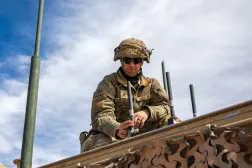Achieving digital integration across allies: Lessons learned from Project Convergence

Today’s geopolitical tensions make digital interoperability among foreign allies paramount. But with the U.S.’s adversaries growing in size and technological complexity, our threat landscape demands even more than just interoperability. To effectively address today’s challenges and realize the impact of true Combined Joint All-Domain and Control (CJADC2), the U.S. and its allies and partners must strive for total seamless digital integration.
The effectiveness of this working toward and eventually achieving true integration was recently examined during Project Convergence Capstone 4 (PCC4), which took place over several weeks spanning February and March 2024. Hosted by the U.S. Army, PCC4 acts as an experimentation venue for joint services and multinational partners to test capabilities and concepts associated with CJADC2. This year’s exercise achieved a higher level of integration between mission partners than has even been achieved in previous CJADC2 experimentation — by, with and through experimental software that the U.K. largely championed to speed up the notoriously manual workflows around a coalition’s command and control of targeting.
While the inevitable “scripting” of outcomes for higher visibility of course took place, PCC4 served as a prime model for some key areas of defense-industry partnership that should be replicated in future exercises, experiments and actual missions to bring our allies closer together. Capstone is just one example of how the right technology and industry partner matched with the right government sponsors can generate mission-critical digital integration.
The success of Capstone yielded three major takeaways on government-industry partnerships:
Lesson learned #1: Warfighter input is critical
Continuous warfighter input and corresponding agile development are critical in identifying rapidly achievable software improvements. At Capstone, industry operational and technical expertise listened to and understood the sponsor’s operational needs and employed an agile development process to ensure rapid and responsive software updates were conducted successfully throughout the event. Some software even required 10 instances of produced and deployed code on a single day PCC4 execution. This model demonstrated the powerful impact of agile development with warfighter input, specifically the speed and accuracy with which software can be modified and improved to align with warfighter needs. It also hit home the fact that this model will need to occur in conflict, not just experimentation. Industry will need to be at the edges of warfare, right alongside the users of their capabilities.
In preparation for future experiments, DOD leaders should establish structured and ongoing processes to gather continuous warfighter feedback. This feedback should be gathered from various operations and echelons of the chain of command to ensure all experiences are accounted for.
Lesson learned #2: Interoperability and security come first
Capstone specifically leveraged mature prototypes with proven data-centric security models, along with identity, credentialing, and access management (ICAM) capabilities, allowing partnerships to establish a zero-trust environment that empowered the secure sharing of data across the U.K. and the U.S. The real challenge wasn’t actually the interoperability between allies but between industry organizations. Without the U.S. Army (or anyone else) clearly defining and mandating a set of standards to govern data sharing, it was left entirely to industry to determine if they were willing to share, and why. Needless to say, allowing business calculus to impact experimentation outcomes was a losing battle.
For future exercises, defense and industry leaders should collaborate on best practices to make more standardized protocols or guidelines for data sharing and handling, making a certain standard for interoperability and security a necessity.
Lesson learned #3: Avoid vendor lock-in
Many forget that experimentations like Capstone, by its nature, involve trial and error. This requires removing the layer of vendor preference that is ever-present at these events. Government and industry need to fully embrace experiments as a space to fail safely and explore new methods for testing integration capabilities — as well as to entertain other capabilities and industry partners to fill gaps. This approach underscores the importance of the DOD remaining flexible and agile, avoiding reliance on a single vendor for an entire problem area, especially in the software space, where any proficient software capability can become any solution with enough money and time. Additionally, to promote ongoing innovation, the DOD must continue to foster an environment where increasing competition ensures that the “best solution” is based strictly on performance, not just preference.
At Capstone, many can agree that U.K. participants were successful in part due to their openness to collaborating with a diverse range of vendors that were focused on a single problem (as in, not just a diverse range of problems each with a single vendor), as well as bringing their own solutions to bear. The U.S. should aim to convey this same openness within future experiments. This entails limiting pre-ordained outcomes and fully embracing a variety of software vendors, technologies and approaches.
PCC4 represented a golden opportunity for government-industry collaboration on real operational problems, leveraging emerging technology and capturing feedback to rapidly improve the technology to meet warfighter requirements. As CJADC2 continues to mature and improve, we must continue to reflect on our past successes and identify new opportunities to advance integration.
Nick Woodruff is the chief strategy officer at Research Innovations Inc. (RII). He’s responsible for the development of partnerships, both domestic and internationally, and the leadership of select strategic initiatives in pursuit of global impact. He previously served in uniform for 14 years in organizations within U.S. Special Operations Command, including as a professional in information and unconventional warfare.
Chris Compton is the senior capture manager at Research Innovations Inc. (RII). He’s responsible for driving strategy and development of RII’s Joint Targeting Platform, a suite of software capabilities designed to enable joint targeting and employment of all-domain fires and effects. He previously served in the U.S. Army for more than 26 years, which included an assignment as chief of concepts development at the Fires Center of Excellence.






